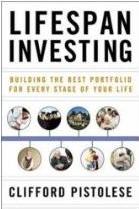Some people say that investing is a game of timing. No matter what type of investor you are, timing is very important. Right timing will tell you when to get into a certain time of investment and when to get out. The question of timing also answers when it is best time to invest in a certain type of investment vehicle. Simply put, proper timing will tell you the best time to invest.
Most experts agree that nobody can predict with certainty what the pattern of the markets will be, hence it can be concluded that nobody can know for certain when is the best time to invest. However we can always make an educated guess on when is the best time to invest. This is much better than just leaving everything to fate.
 I mentioned in my pervious post “How Warren Buffett made me poor” that I was taking a “Buffett break” and that before proceeding with my 5th Buffett book, I will be reading another financial management book. The book that I just read is entitled “Lifespan Investing” by Clifford Pistolese.
I mentioned in my pervious post “How Warren Buffett made me poor” that I was taking a “Buffett break” and that before proceeding with my 5th Buffett book, I will be reading another financial management book. The book that I just read is entitled “Lifespan Investing” by Clifford Pistolese.
Pistolese may not be Warren Buffett but he is the author of several investment books, a successful investor and has held several executive posts in well known corporations.
As the title implies, Lifespan investing shows the reader the best time to invest in what age bracket a person is in his life.
According to Pistolese, “Wise investors don’t try to waste time trying to capitalize on current market trends for short-term gains; rather they focus on making their wealth grow over a lifetime” I certainly agree.
No book on knowing the best time to invest would be complete without discussing the fundamentals of investment namely fundamental analysis and technical analysis which are the subject of the first two chapters. Fundamental analysis simply tells you what securities to buy whereas technical analysis tells you when to buy and sell your investments.
The third chapter gives you a glimpse on what is portfolio management. Chapters 4 to 13 deals with Portofolio management as divided in 5 year periods. (Ages 20 to 25, 26 to 30 and so on.) In these chapters you can find the different portfolio management strategy you should adopt depending on your age bracket and depending on the market type existing during that time. For example if you are aged 20 to 25, the book will show you what investing strategy to adopt during a bull market, a bear market or a range bound market. In short it shows you when the best time to invest is, when the best time to take a defensive stand and when is the best time to preserve capital.
The last two chapters deal with portfolio management age 60 up and retirement. The book ends with an overview on Life Span Investing. The glossary provides a definition of common investment terms. A section is also devoted to useful internet resources that will assist you in your investing choices.
I would recommend Life Span investing to be a good reading most especially to those who are still in their early 20s or their teenage years as these are the best time to invest especially after they started to work and put on their nurses uniforms. However the books advices are still valuable to whatever age bracket a person is in as it shows you the best time to invest no matter what the age bracket.
Unfortunately most of the examples, stock recommendations and vehicles of investments suggested in the book are based in the United States setting. It is not very useful to us here in the Philippines since most of the investment vehicles suggested in the book are only available in the United States. For example one of the vehicles of investment being discussed frequently in the book is the Real Estate Investment funds (REIT). We still do not have it here in the Philippines. However I read in the news the other day that a bill is being passed in Congress concerning this matter. I will make this the subject of another post. I do hope that someday somebody will come up with “Life Span investing: Philippine edition” (Or perhaps I shall write one someday who knows? hehehehe?)
I would prefer though that the author did not give any stock recommendation or even any particular fund recommendation. I presume that when he wrote this, the world financial crises have not yet affected major financial institutions because he has recommended investing in some of the funds of some major financial institutions. Now that the global crises have hit these institutions, I believe the “credibility” of the advices given in the book has somehow been affected.
Nevertheless the book is still very useful when it comes to portfolio management and knowing the best time to invest and what to invest in a certain age bracket and at a given market type.
If you would like to get a copy of the book, buy it here out at my Guerilla Blogger’s eStore. Now is the best time to invest in a good financial management book!
 Hi ! my name is Zigfred Diaz. Thanks for visiting my personal blog ! Never miss a post from this blog. Subscribe to my full feeds for free. Click here to subscribe to zdiaz.com by Email
Hi ! my name is Zigfred Diaz. Thanks for visiting my personal blog ! Never miss a post from this blog. Subscribe to my full feeds for free. Click here to subscribe to zdiaz.com by Email
You may also want to visit my other blogs. Click here to learn more about great travel ideas.

yeah, why not write it?
you definitely have the resources and the connections to accountants and the like if you ever need it, right?
Cathy: Probably later, I still want to formalize my education in Finance and Financial Management. I mean a know several stuff already and read a lot of books, and has some experience but you know people in the Philippines, you are not considered an expert if you have not had a formal education in your alleged areas of expertise. Plus I want to be eligble to teach finance in college, so I need to get a formal training somehow. Any suggestions ? I don’t know if I’ll take up banking in finance in the unergrad or take up a MBA with a major in finance